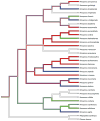Vocal dialects in parrots: patterns and processes of cultural evolution
- PMID: 29962561
- PMCID: PMC6020700
- DOI: 10.1080/01584197.2017.1379356
Vocal dialects in parrots: patterns and processes of cultural evolution
Abstract
Vocal dialects have fascinated biologists for over 50 years. This mosaic pattern of geographic variation in learned vocalizations was first described in a songbird, and since that time, most studies investigating dialects have focused on songbird species. Here we examine patterns of geographic variation in the calls of a different group of vocal learning birds, the parrots (Order Psittaciformes). We summarize the growing literature on vocal variation in parrots, and complement this review with a survey of variation in the genus Amazona using calls from sound libraries. We find strikingly similar patterns to those previously found in songbirds. Over 90% of parrots examined in the literature, and 69% of Amazona species surveyed, showed geographic variation consistent with a propensity to share local call types. This trait is evolutionarily labile and widespread; within Amazona most clades contained species with and without geographic variation, and most major lineages of parrots include representatives with dialects. We found little support for the long-standing hypothesis that dialects isolate populations and thus generate genetic differences among populations. Instead, most studies support the idea that dialects are maintained by social benefits of matching local call types, a finding that has implications for the management of captive and endangered populations. Considerable scope remains for studies that experimentally test hypotheses for the exact nature of these benefits, as well as studies that employ comparisons among species, to understand how the interplay between ecology, social dynamics and vocal learning capacities produces different patterns of variation across the parrots.
Keywords: Psittaciformes; contact calls; cultural evolution; dialect; geographic variation; parrots.
Figures



References
-
- Baker MC. Vocal dialect recognition and population genetic consequences. American Zoologist. 1982;22(3):561–569.
-
- Baker MC. Cultural diversification in the flight call of the Ringneck Parrot in Western Australia. Condor. 2000;102(4):905–910.
-
- Baker MC. Local similarity and geographic differences in a contact call of the galah (Cacatua roseicapilla assimilis) in Western Australia. Emu. 2003;103:233–237.
-
- Baker MC. Analysis of a cultural trait across an avian hybrid zone: Geographic variation in plumage morphology and vocal traits in the Australian Ringneck Parrot (Platycercus zonarius) Auk. 2008;125(3):651–662.
-
- Baker MC. Geographic variation of three vocal signals in the Australian ringneck (Aves: Psittaciformes): Do functionally similar signals have similar spatial distributions? Behaviour. 2011;148(3):373–402.
Grants and funding
LinkOut - more resources
Full Text Sources
Other Literature Sources
Miscellaneous
